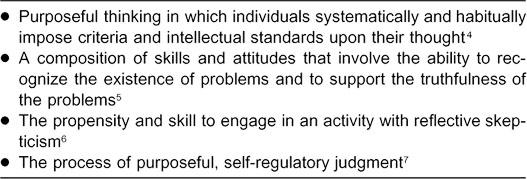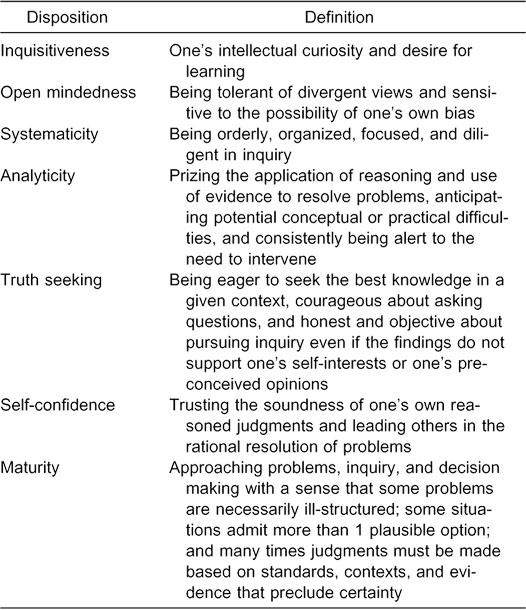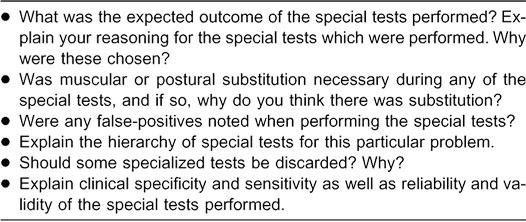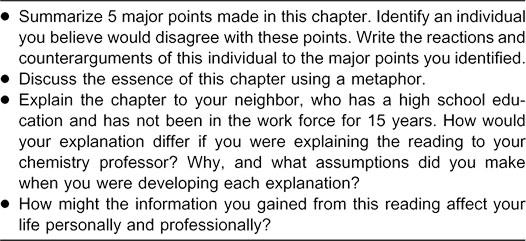Abstract
Objective:
To provide a brief introduction to the definition and disposition to think critically along with active learning strategies to promote critical thinking.
Data Sources:
I searched MEDLINE and Educational Resources Information Center (ERIC) from 1933 to 2002 for literature related to critical thinking, the disposition to think critically, questioning, and various critical-thinking pedagogic techniques.
Data Synthesis:
The development of critical thinking has been the topic of many educational articles recently. Numerous instructional methods exist to promote thought and active learning in the classroom, including case studies, discussion methods, written exercises, questioning techniques, and debates. Three methods—questioning, written exercises, and discussion and debates—are highlighted.
Conclusions/Recommendations:
The definition of critical thinking, the disposition to think critically, and different teaching strategies are featured. Although not appropriate for all subject matter and classes, these learning strategies can be used and adapted to facilitate critical thinking and active participation.
Keywords: athletic training education
The development of critical thinking (CT) has been a focus of educators at every level of education for years. Imagine a certified athletic trainer (ATC) who does not consider all of the injury options when performing an assessment or an ATC who fails to consider using any new rehabilitation techniques because the ones used for years have worked. Envision ATCs who are unable to react calmly during an emergency because, although they designed the emergency action plan, they never practiced it or mentally prepared for an emergency. These are all examples of situations in which ATCs must think critically.
Presently, athletic training educators are teaching many competencies and proficiencies to entry-level athletic training students. As Davies1 pointed out, CT is needed in clinical decision making because of the many changes occurring in education, technology, and health care reform. Yet little information exists in the athletic training literature regarding CT and methods to promote thought. Fuller,2 using the Bloom taxonomy, classified learning objectives, written assignments, and examinations as CT and nonCT. Athletic training educators fostered more CT in their learning objectives and written assignments than in examinations. The disposition of athletic training students to think critically exists but is weak. Leaver-Dunn et al3 concluded that teaching methods that promote the various components of CT should be used. My purpose is to provide a brief introduction to the definition and disposition to think critically along with active learning strategies to promote CT.
DEFINITION OF CRITICAL THINKING
Four commonly referenced definitions of critical thinking are provided in Table 1. All of these definitions describe an individual who is actively engaged in the thought process. Not only is this person evaluating, analyzing, and interpreting the information, he or she is also analyzing inferences and assumptions made regarding that information. The use of CT skills such as analysis of inferences and assumptions shows involvement in the CT process. These cognitive skills are employed to form a judgment. Reflective thinking, defined by Dewey8 as the type of thinking that consists of turning a subject over in the mind and giving it serious and consecutive consideration, can be used to evaluate the quality of judgment(s) made.9 Unfortunately, not everyone uses CT when solving problems. Therefore, in order to think critically, there must be a certain amount of self-awareness and other characteristics present to enable a person to explain the analysis and interpretation and to evaluate any inferences made.
Table 1.
Various Definitions of Critical Thinking

DISPOSITION TO THINK CRITICALLY
Recently researchers have begun to investigate the relationship between the disposition to think critically and CT skills. Many believe that in order to develop CT skills, the disposition to think critically must be nurtured as well.4,10–12 Although research related to the disposition to think critically has recently increased, as far back as 1933 Dewey8 argued that possession of knowledge is no guarantee for the ability to think well but that an individual must desire to think. Open mindedness, wholeheartedness, and responsibility were 3 of the attitudes he felt were important traits of character to develop the habit of thinking.8
More recently, the American Philosophical Association Delphi report on critical thinking7 was released in 1990. This report resulted from a questionnaire regarding CT completed by a cross-disciplinary panel of experts from the United States and Canada. Findings included continued support for the theory that to develop CT, an individual must possess and use certain dispositional characteristics. Based upon the dispositional phrases, the California Critical Thinking Dispositional Inventory13 was developed. Seven dispositions (Table 2) were derived from the original 19 published in the Delphi report.12 It is important to note that these are attitudes or affects, which are sought after in an individual, and not thinking skills. Facione et al9 purported that a person who thinks critically uses these 7 dispositions to form and make judgments. For example, if an individual is not truth seeking, he or she may not consider other opinions or theories regarding an issue or problem before forming an opinion. A student may possess the knowledge to think critically about an issue, but if these dispositional affects do not work in concert, the student may fail to analyze, evaluate, and synthesize the information to think critically. More research is needed to determine the relationship between CT and the disposition to think critically.
Table 2.
Dispositions to Think Critically12

METHODS TO PROMOTE CRITICAL THOUGHT
Educators can use various instructional methods to promote CT and problem solving. Although educators value a student who thinks critically about concepts, the spirit or disposition to think critically is, unfortunately, not always present in all students. Many college faculty expect their students to think critically.14 Some nursing-specific common assumptions made by university nursing teaching faculty are provided15 (Table 3) because no similar research exists in athletic training. Espeland and Shanta16 argued that faculty who select lecture formats as a large part of their teaching strategy may be enabling students. When lecturing, the instructor organizes and presents essential information without student input. This practice eliminates the opportunity for students to decide for themselves what information is important to know. For example, instead of telling our students via lecture what medications could be given to athletes with an upper respiratory infection, they could be assigned to investigate medications and decide which one is appropriate.
Table 3.
Common Assumptions of Nursing Faculty15

Students need to be exposed to diverse teaching methods that promote CT in order to nurture the CT process.14,17–19 As pointed out by Kloss,20 sometimes students are stuck and unable to understand that various answers exist for one problem. Each ATC has a different method of taping a sprained ankle, performing special tests, and obtaining medical information. Kloss20 stated that students must be exposed to ambiguity and multiple interpretations and perspectives of a situation or problem in order to stimulate growth. As students move through their clinical experiences, they witness the various methods for taping ankles, performing special tests, and obtaining a thorough history from an injured athlete. Paul and Elder21 stated that many professors may try to encourage students to learn a body of knowledge by stating that body of knowledge in a sequence of lectures and then asking students to internalize knowledge outside of class on their own time. Not all students possess the thinking skills to analyze and synthesize information without practice. The following 3 sections present information and examples of different teaching techniques to promote CT.
Questioning
An assortment of questioning tactics exists to promote CT. Depending on how a question is asked, the student may use various CT skills such as interpretation, analysis, and recognition of assumptions to form a conclusion. Mills22 suggested that the thoughtful use of questions may be the quintessential activity of an effective teacher. Questions are only as good as the thought put into them and should go beyond knowledge-level recall.22 Researchers23,24 have found that often clinical teachers asked significantly more lower-level cognitive questions than higher-level questions. Questions should be designed to promote evaluation and synthesis of facts and concepts. Asking a student to evaluate when proprioception exercises should be included in a rehabilitation program is more challenging than asking a student to define proprioception. Higher-level thinking questions should start or end with words or phrases such as, “explain,” “compare,” “why,” “which is a solution to the problem,” “what is the best and why,” and “do you agree or disagree with this statement?” For example, a student could be asked to compare the use of parachlorophenylalanine versus serotonin for control of posttreatment soreness. Examples of words that can be used to begin questions to challenge at the different levels of the Bloom Taxonomy25 are given in Table 4. The Bloom Taxonomy25 is a hierarchy of thinking skills that ranges from simple skills, such as knowledge, to complex thinking, such as evaluation. Depending on the initial words used in the question, students can be challenged at different levels of cognition.
Table 4.
Examples of Questions23

Another type of questioning technique is Socratic questioning. Socratic questioning is defined as a type of questioning that deeply probes or explores the meaning, justification, or logical strength of a claim, position, or line of reasoning.4,26 Questions are asked that investigate assumptions, viewpoints, consequences, and evidence. Questioning methods, such as calling on students who do not have their hands up, can enhance learning by engaging students to think. The Socratic method focuses on clarification. A student's answer to a question can be followed by asking a fellow student to summarize the previous answer. Summarizing the information allows the student to demonstrate whether he or she was listening, had digested the information, and understood it enough to put it into his or her own words. Avoiding questions with one set answer allows for different viewpoints and encourages students to compare problems and approaches. Asking students to explain how the high school and the collegiate or university field experiences are similar and different is an example. There is no right or wrong answer because the answers depend upon the individual student's experiences.19 Regardless of the answer, the student must think critically about the topic to form a conclusion of how the field experiences are different and similar.
In addition to using these questioning techniques, it is equally important to orient the students to this type of classroom interaction. Mills22 suggested that provocative questions should be brief and contain only one or two issues at a time for class reflection. It is also important to provide deliberate silence, or “wait” time, for students upon asking questions.22,27 Waiting at least 5 seconds allows the students to think and encourages thought. Elliot18 argued that waiting even as long as 10 seconds allows the students time to think about possibilities. If a thought question is asked, time must be given for the students to think about the answer.
Classroom Discussion and Debates
Classroom discussion and debates can promote critical thinking. Various techniques are available. Bernstein28 developed a negotiation model in which students were confronted with credible but antagonistic arguments. Students were challenged to deal with the tension between the two arguments. This tension is believed to be one component driving critical thought. Controversial issues in psychology, such as animal rights and pornography, were presented and discussed. Students responded favorably and, as the class progressed over time, they reported being more comfortable arguing both sides of an issue. In athletic training education, a negotiation model could be employed to discuss certain topics, such as the use of heat versus ice or the use of ultrasound versus electric stimulation in the treatment of an injury. Students could be assigned to defend the use of a certain treatment. Another strategy to promote students to seek both sides of an issue is pro and con grids.29 Students create grids with the pros and cons or advantages or disadvantages of an issue or treatment. Debate was used to promote CT in second-year medical students.30 After debating, students reported improvements in literature searching, weighing risks and benefits of treatments, and making evidence-based decisions. Regardless of the teaching methods used, students should be exposed to analyzing the costs and benefits of issues, problems, and treatments to help prepare them for real-life decision making.
Observing the reasoning skills of another person was used by Galotti31 to promote CT. Students were paired, and 4 reasoning tasks were administered. As the tasks were administered, students were told to talk aloud through the reasoning process of their decisions. Students who were observing were to write down key phrases and statements. This same process can be used in an injury-evaluation class. One student performs an evaluation while the others in the class observe. Classroom discussion can then follow. Another alternative is to divide students into pairs. One student performs an evaluation while the other observes. After the evaluation is completed, the students discuss with each other the evaluation (Table 5 presents examples). Another option is to have athletic training students observe a student peer or ATC during a field evaluation of an athlete. While observing, the student can write down any questions or topics to discuss after the evaluation, providing the student an opportunity to ask why certain evaluation methods were and were not used.
Table 5.
Postevaluation Questions

Daily newspaper clippings directly related to current classroom content also allow an instructor to incorporate discussion into the classroom.32 For example, an athlete who has been reported to have died as a result of heat illness could provide subject matter for classroom discussion or various written assignments. Such news also affords the instructor an opportunity to discuss the affective components involved. Students could be asked to step into the role of the ATC and think about the reported implications of this death from different perspectives. They could also list any assumptions made by the article or follow-up questions they would ask if they could interview the persons involved. This provides a forum to enlighten students to think for themselves and realize that not each person in the room perceives the article the same way. Whatever the approach taken, investigators and educators agree that assignments and arguments are useful to promote thought among students.
Written Assignments
In-class and out-of-class assignments can also serve as powerful vehicles to allow students to expand their thinking processes. Emig33 believed that involving students in writing serves their learning uniquely because writing, as process and product, possesses a cluster of attributes that correspond uniquely to certain powerful learning strategies. As a general rule, assignments for the purpose of promoting thought should be short (not long term papers) and focus on the aspect of thinking.19 Research or 1-topic papers may or may not be a student's own thoughts, and Meyers32 argued that term papers often prove to be exercises in recapitulating the thoughts of others.
Allegretti and Frederick34 used a variety of cases from a book to promote CT regarding different ethical issues. Countless case-study situations can be created to allow students to practice managing situations and assess clinical decision making. For example, after reading the National Athletic Trainers' Association position statement on lightning, a student can be asked to address the following scenario: “Explain how you would handle a situation in which a coach has kept athletes outside practicing unsafely. What information would you use from this statement to explain your concerns? Explain why you picked the specific concerns.” These questions can be answered individually or in small groups and then discussed in class. The students will pick different concerns based on their thinking. This variety in answers is not only one way to show that no answer is right or wrong but also allows students to defend their answers to peers. Questions posed on listservs are excellent avenues to enrich a student's education. Using these real-life questions, students read about real issues and concerns of ATCs. These topics present excellent opportunities to pose questions to senior-level athletic training students to examine how they would handle the situation. This provides the students a safe place to analyze the problem and form a decision. Once the students make a decision, additional factors, assumptions, and inferences can be discussed by having all students share the solution they chose.
Lantz and Meyers35 used personification and assigned students to assume the character of a drug. Students were to relate themselves to the drug, in the belief that drugs exhibit many unique characteristics, such as belonging to a family, interaction problems, adverse reactions, and so forth. The development of analogies comes from experience and comparing one theory or scenario to another with strong similarities.
Fopma-Loy and Ulrich36 identified various CT classroom exercises educators can implement to promote higher-order thought (Table 6). Many incorporate a personal reaction from the student and allow the student to link that learning to his or her feelings. This personal reaction of feelings to cognitive information is important to show the relevance of material.
Table 6.
Exercises to Promote Critical Thought36

Last, poems are another avenue that can be used to promote CT.20 Although poems are widely thought of as an assignment in an English class, athletic training students may benefit from this creative writing activity. The focus of this type of homework activity should be on reviewing content creatively. The lines of the poem need not rhyme as long as appropriate content is explained in the poem. For example, a poem on the knee could be required to include signs, symptoms, and anatomical content of one injury or various injuries. A poem on head injuries could focus on the different types of history questions that should be asked. Students should understand that the focus of the assignment is a creative review of the material and not a test of their poetic qualities. The instructor should complete a poem as well. To break the ice, the instructor's poem can be read first, followed by a student volunteering to read his or her poem.
CONCLUSIONS
Regardless of the methods used to promote CT, care must be taken to consider the many factors that may inhibit a student from thinking critically. The student's disposition to think critically is a major factor, and if a deficit in a disposition is noticed, this should be nurtured. Students should be encouraged to be inquisitive, ask questions, and not believe and accept everything they are told. As pointed out by Loving and Wilson14 and Oermann,19 thought develops with practice and evaluation over time using multiple strategies. Additionally, faculty should be aware of their course goals and learning objectives. If these goals and objectives are stated as higher-order thought outcomes, then activities that promote CT should be included in classroom activities and assignments.14 Finally, it is important that CT skills be encouraged and reinforced in all classes by teaching faculty, not only at the college level but at every level of education. Although huge gains in CT may not be reflected in all college students, we can still plant the seed and encourage students to use their thinking abilities in the hope these will grow over time.
REFERENCES
- 1.Davies GJ. The need for critical thinking in rehabilitation. J Sport Rehabil. 1995;4:1–22. [Google Scholar]
- 2.Fuller D. Critical thinking in undergraduate athletic training education. J Athl Train. 1997;32:242–247. [PMC free article] [PubMed] [Google Scholar]
- 3.Leaver-Dunn D, Harrelson GL, Martin M, Wyatt T. Critical-thinking predisposition among undergraduate athletic training students. J Athl Train. 2002;37(4 suppl):S147–S151. [PMC free article] [PubMed] [Google Scholar]
- 4.Paul R. How to Prepare Students For A Rapidly Changing World. Santa Rosa, CA: Foundation for Critical Thinking; 1995. [Google Scholar]
- 5.Watson GB, Glaser EM. Test Manual: The Watson Glaser Critical Thinking Appraisal. San Antonio, TX: Psychological Corp; 1994. [Google Scholar]
- 6.McPeck JE. Teaching Critical Thinking: Dialogue and Dialect. New York, NY: Routledge; 1990. [Google Scholar]
- 7.American Philosophical Association. Critical Thinking, The Delphi Report: Research Findings and Recommendations Prepared for the Committee on Pre-College Philosophy. San Francisco, CA: California Academic Press; 1990. [Google Scholar]
- 8.Dewey J. How We Think. 2nd ed. Boston, MA: DC Heath; 1933. [Google Scholar]
- 9.Facione PA, Sanchez CA, Facione NC, Gainen J. The disposition toward critical thinking. J Gen Educ. 1995;44:1–25. [Google Scholar]
- 10.Bailin S, Case R, Coombs JR, Daniels LB. Common misconceptions of critical thinking. J Curriculum Stud. 1999;31:269–283. [Google Scholar]
- 11.Daly WM. The development of an alternative method in the assessment of critical thinking as an outcome of nursing education. J Adv Nurs. 2001;36:120–130. doi: 10.1046/j.1365-2648.2001.01949.x. [DOI] [PubMed] [Google Scholar]
- 12.Facione NC, Facione PA, Sanchez CA. Critical thinking disposition as a measure of competent clinical judgment: the development of the California Critical Thinking Disposition Inventory. J Nurs Educ. 1994;33:345–350. doi: 10.3928/0148-4834-19941001-05. [DOI] [PubMed] [Google Scholar]
- 13.Facione PA, Facione NC, Giancarlo CA. Test Manual: The California Critical Thinking Disposition Inventory. Millbrae, CA: Insight Assessment; 2000. [Google Scholar]
- 14.Loving GL, Wilson JS. Infusing critical thinking into the nursing curriculum through faculty development. Nurs Educ. 2000;25:70–75. doi: 10.1097/00006223-200003000-00008. [DOI] [PubMed] [Google Scholar]
- 15.Miller MA, Malcom NS. Critical thinking in the nursing curriculum. Nurs Health Care. 1990;11:67–73. [PubMed] [Google Scholar]
- 16.Espeland K, Shanta L. Empowering versus enabling in academia. J Nurs Educ. 2001;40:342–346. doi: 10.3928/0148-4834-20011101-04. [DOI] [PubMed] [Google Scholar]
- 17.Chaffee J. Critical thinking skills: the cornerstone of developmental education. J Develop Educ. 1992;15:2–39. [Google Scholar]
- 18.Elliot DD. Promoting critical thinking in the classroom. Nurse Educ. 1996;21:49–52. doi: 10.1097/00006223-199603000-00015. [DOI] [PubMed] [Google Scholar]
- 19.Oermann MH. Evaluating critical thinking in clinical practice. Nurse Educ. 1997;22:25–28. doi: 10.1097/00006223-199709000-00011. [DOI] [PubMed] [Google Scholar]
- 20.Kloss RJ. A nudge is best: helping students through the Perry Scheme of intellectual development. College Teach. 1994;42:151–158. [Google Scholar]
- 21.Paul R, Elder L. Critical Thinking: Tools for Taking Charge of Your Learning and Your Life. Upper Saddle River, NJ: Prentice Hall; 2001. [Google Scholar]
- 22.Mills J. Better teaching through provocation. College Teach. 1995;46:21–25. [Google Scholar]
- 23.Craig JL, Page G. The questioning skills of nursing instructors. J Nurs Educ. 1981;20:18–23. doi: 10.3928/0148-4834-19810501-06. [DOI] [PubMed] [Google Scholar]
- 24.Phillips N, Duke M. The questioning skills of clinical teachers and preceptors: a comparative study. J Adv Nurs. 2001;33:523–529. doi: 10.1046/j.1365-2648.2001.01682.x. [DOI] [PubMed] [Google Scholar]
- 25.Bloom BS, Engelhart MD, Furst EJ, Hill WH, Krathwohl DR. Taxonomy of Educational Objectives, Handbook 1: Cognitive Domain. New York, NY: Longmans; 1956. [Google Scholar]
- 26.Paul RW, Heaslip P. Critical thinking and intuitive nursing practice. J Adv Nurs. 1995;22:40–47. doi: 10.1046/j.1365-2648.1995.22010040.x. [DOI] [PubMed] [Google Scholar]
- 27.Dillon JT. The Practice of Questioning. London, England: Routledge; 1990. [Google Scholar]
- 28.Bernstein D. A negotiation model for teaching critical thinking. Teach Psychol. 1985;22:22–24. [Google Scholar]
- 29.Tomey AM. Problem-solving and critical thinking assessment. Nurse Educ. 2000;25:9–11. doi: 10.1097/00006223-200001000-00010. [DOI] [PubMed] [Google Scholar]
- 30.Lieberman SA, Trumble JM, Smith ER. The impact of structured student debates on critical thinking and informatics skills of second-year medical students. Acad Med. 2000;75(10 suppl):S84–S86. doi: 10.1097/00001888-200010001-00027. [DOI] [PubMed] [Google Scholar]
- 31.Galotti KM. Reasoning about reasoning: a course project. Teach Psychol. 1995;22:66–68. [Google Scholar]
- 32.Meyers C. Teaching Students to Think Critically. San Francisco, CA: Jossey-Bass; 1986. [Google Scholar]
- 33.Emig J. The Web of Meaning. Upper Montclair, NJ: Boynton/Cook; 1983. [Google Scholar]
- 34.Allegretti CL, Frederick JN. A model for thinking critically about ethical issues. Teach Psychol. 1995;22:46–48. [Google Scholar]
- 35.Lantz M, Meyers GD. Critical thinking through writing: using personification to teach pharmacodynamics. J Nurs Educ. 1986;25:64–66. doi: 10.3928/0148-4834-19860201-07. [DOI] [PubMed] [Google Scholar]
- 36.Fopma-Loy J, Ulrich D. Spotlight on…seventeen ways to transform reading assignments into critical thinking experiences. Nurse Educ. 1999;24:11–13. doi: 10.1097/00006223-199909000-00009. [DOI] [PubMed] [Google Scholar]


